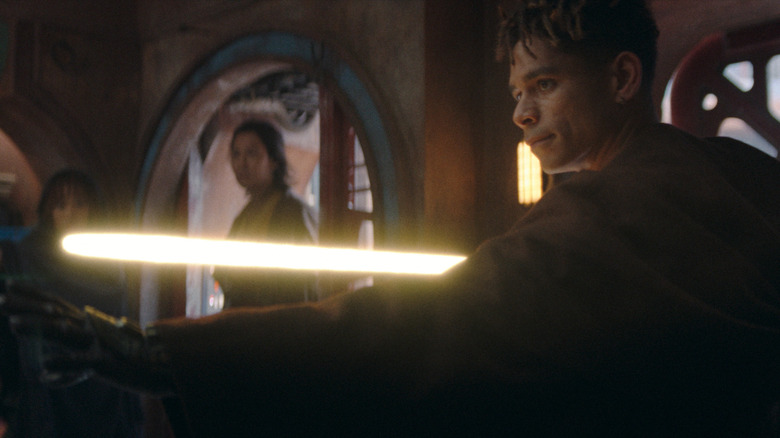The Acolyte's Biggest Lightsaber Rule 'Breaks' Star Wars Canon - Or Does It?
During "Star Wars: The Acolyte," Mae (Amandla Stenberg) says, "A Jedi doesn't pull her weapon unless prepared to kill." But that statement isn't necessarily followed up by what occurs in "Star Wars" canon — or even in "The Acolyte" itself. To wit, Yord Fandar (Charlie Barnett) pulls out his yellow lightsaber during the course of the series and uses it as a flashlight. Lightsabers are used as a light source in the animated "Clone Wars" series as well.
There are multiple examples of other Jedi using their lightsabers for reasons that have nothing to do with protecting themselves or others that stretch far beyond this moment, like Qui-Gon Gin (Liam Neeson) using his lightsaber to cut through the blast door of a ship in "Star Wars: Episode I — The Phantom Menace." Han Solo (Harrison Ford) even uses Luke Skywalker's (Mark Hamill) as a cutting tool to get inside Luke's deceased tauntaun to avoid his freezing to death in "Star Wars: Episode V — The Empire Strikes Back."
That's one heck of a Jedi mind trick. But, on the other hand, Mae might simply be working with the knowledge she has from her own life experience, where members of the Jedi are feared veterans of a scarring war that has left the remaining members of the order notorious throughout the galaxy as fierce peacekeepers. And there might be an even deeper reason for Mae's comment.
The philosophy of The Acolyte reflects a changing galaxy
There might be a whole other reason why Mae thinks lightsabers are only drawn by their wielders in battle situations — changing moral climates in the galaxy over the centuries. "The Acolyte" takes place about a century before the rise of the sand-hating Anakin Skywalker (Hayden Christensen), the rise of the Empire, and the decimation of the Jedi Order. By the time Luke Skywalker comes of age and wields his father's lightsaber, the entire code of Jedi conduct has changed from a more warlike and militaristic order to a more feudal and samurai-like code of conduct.
Rules of conduct change yet again by the time Rey (Daisy Ridley) comes of age — the Jedi are part of the Resistance, and despite Luke's attempt at building a school, the Jedi fall and are decimated again. So fans comparing what Luke experienced and what Mae is experiencing might just be barking up the wrong tree. Her contact with Jedi like Yord Fandar serves as part of her evolving point of view on the topic as well.
In any event, this peek into Jedi history definitely helps build a picture of how things have changed over the centuries — even if "The Acolyte" is dividing the "Star Wars" fandom.

